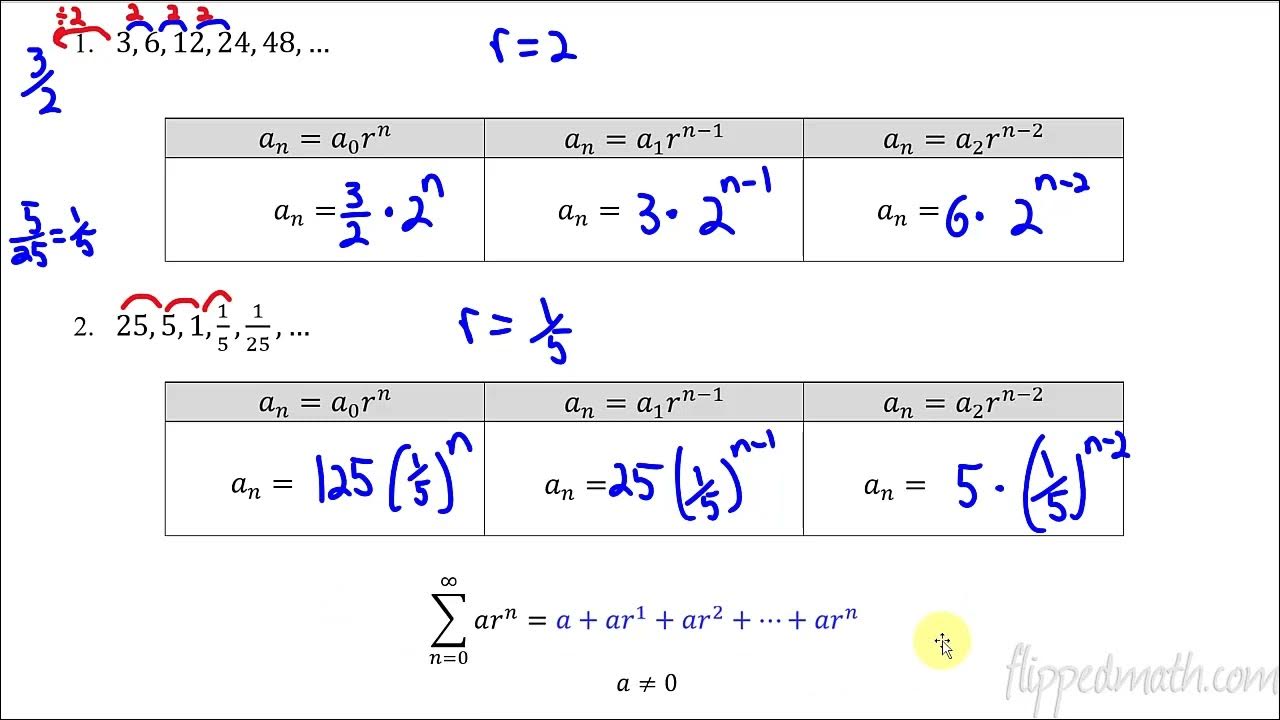Worked example: divergent geometric series | Series | AP Calculus BC | Khan Academy
TLDRThe video script discusses an infinite geometric series with a common ratio of -3. It explores the series' structure, rewriting it in different forms, and ultimately concludes that the series does not converge due to the absolute value of the common ratio being greater than one, leading to increasing term magnitudes.
Takeaways
- 🔍 The script discusses an infinite series that appears to be a geometric series with a common ratio of -3.
- 📚 The series is rewritten as a sum involving powers of -3, starting with -0.5 times -3 raised to the power of 0, 1, 2, and so on.
- 🔢 The series is expressed in sigma notation, which is a formal way to represent the sum of a sequence.
- 🚫 The absolute value of the common ratio (|-3|) is 3, which is greater than 1, indicating that the series does not converge.
- 🌐 The concept of convergence is explained, where for a series to converge, the magnitude of the common ratio must be less than 1.
- 📉 The script points out that the terms of the series are getting larger in magnitude, which is contrary to the behavior of a converging series.
- 🔄 The series alternates between adding and subtracting, but the values involved are increasing, suggesting divergence.
- 🤔 The script uses intuitive reasoning to explain why the series does not converge, as successive terms do not diminish in size.
- 📝 The series is analyzed both algebraically and conceptually to understand its behavior and the implications of the common ratio.
- 📈 The script provides a clear example of how to identify and evaluate the convergence of a geometric series.
- 📚 The educational value of the script is highlighted by its step-by-step explanation and analysis of the series.
Q & A
What type of series is being discussed in the script?
-The script discusses an infinite series that is identified as a geometric series.
What is the common ratio of the series mentioned in the script?
-The common ratio of the series is negative three (-3).
How is the first term of the series described in the script?
-The first term of the series is described as negative 0.5.
What is the significance of the common ratio's absolute value in determining convergence of a series?
-The absolute value of the common ratio must be less than one for a geometric series to converge.
Why does the series in the script not converge?
-The series does not converge because the absolute value of the common ratio, which is three, is not less than one.
What is the sigma notation mentioned in the script, and how is it used?
-Sigma notation is a way to represent the sum of a series. In the script, it is used to express the infinite series with a variable n going from zero to infinity.
How does the script describe the pattern of the series' terms?
-The script describes the pattern as multiplying by negative three to an increasing power for each successive term.
What is the role of the term 'nth power' in the sigma notation used in the script?
-The 'nth power' in the sigma notation represents the exponent for the common ratio in each term of the series as n varies from zero to infinity.
How does the magnitude of the terms in the series change according to the script?
-According to the script, the magnitude of the terms gets larger and larger, indicating that the series is not converging.
What does the script imply about the behavior of a converging series?
-The script implies that in a converging series, each successive term tends to get diminishingly small or cancels out in some way, which is not the case with the series discussed.
What is the intuitive understanding of convergence mentioned in the script?
-The script suggests that for a series to converge intuitively, the terms should get smaller or somehow cancel each other out, which is not happening in the series discussed.
Outlines
📚 Analyzing a Geometric Series
The paragraph introduces an infinite geometric series with a common ratio of -3. The speaker explains the process of rewriting the series using powers of -3, starting from the zeroth power and increasing with each term. The series is represented in sigma notation, highlighting the pattern of multiplication by -0.5 times -3 raised to the nth power. The explanation emphasizes the importance of the absolute value of the common ratio for determining convergence. It concludes by stating that the series does not converge because the absolute value of the common ratio is greater than one, leading to increasingly larger magnitudes of terms that do not diminish, which is a characteristic of a divergent series.
Mindmap
Keywords
💡Infinite series
💡Geometric series
💡Common ratio
💡Convergence
💡Absolute value
💡Sigma notation
💡Power
💡nth power
💡Magnitude
💡Successive term
💡Divergent series
Highlights
The series is identified as a geometric series with a common ratio of -3.
The series is rewritten with each term involving -0.5 multiplied by (-3) raised to increasing powers.
Sigma notation is introduced to represent the infinite sum of the series.
The nth term of the series is expressed as -0.5 times (-3) to the power of n.
The importance of the absolute value of the common ratio for series convergence is emphasized.
The absolute value of the common ratio (3) is greater than 1, indicating divergence.
The series does not converge due to the increasing magnitude of terms.
The concept of convergence is linked to terms diminishing in size or interesting cancellations.
The series' divergence is intuitively explained through the increasing values of addition and subtraction.
The series alternates between addition and subtraction of increasingly larger values.
The series' behavior is contrasted with the expected behavior of a converging series.
The transcript provides a clear explanation of why the series does not meet the convergence criteria.
The mathematical reasoning behind the divergence is thoroughly explained.
The transcript uses visual aids like colors to help distinguish different parts of the series.
The concept of a common ratio and its impact on the series' behavior is well-illustrated.
The transcript concludes with a definitive statement on the series' divergence.
Transcripts
Browse More Related Video

Ratio test | Series | AP Calculus BC | Khan Academy

Sum of an infinite geometric series | Sequences, series and induction | Precalculus | Khan Academy

Power series of ln(1+x_) | Series | AP Calculus BC | Khan Academy

Another derivation of the sum of an infinite geometric series | Precalculus | Khan Academy

AP Calculus BC Exam Review - Geometric Series

Calculus BC – 10.2 Working with Geometric Series
5.0 / 5 (0 votes)
Thanks for rating: